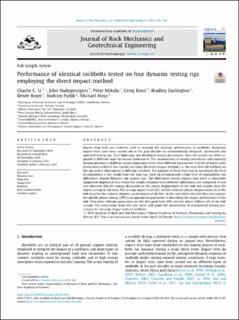| dc.contributor.author | Li, Charlie Chunlin | |
| dc.contributor.author | Hadjigeorgiou, J. | |
| dc.contributor.author | Mikula, P | |
| dc.contributor.author | Knox, G. | |
| dc.contributor.author | Darlington, B. | |
| dc.contributor.author | Royer, R. | |
| dc.contributor.author | Pytlik, A. | |
| dc.contributor.author | Hosp, M. | |
| dc.date.accessioned | 2021-10-15T10:02:21Z | |
| dc.date.available | 2021-10-15T10:02:21Z | |
| dc.date.created | 2021-06-17T15:03:46Z | |
| dc.date.issued | 2021 | |
| dc.identifier.issn | 1674-7755 | |
| dc.identifier.uri | https://hdl.handle.net/11250/2823264 | |
| dc.description.abstract | Impact drop tests are routinely used to examine the dynamic performance of rockbolts. Numerous impact tests have been carried out in the past decades on independently designed, constructed and operated testing rigs. Each laboratory has developed testing procedures; thus, the results are often reported in different ways by various laboratories. The inconsistency in testing procedures and reporting formats presents a challenge when comparing results from different laboratories. A series of impact tests of identical rockbolts was carried out using the direct impact method (i.e. the mass free-fall method) on the rigs in four laboratories in different countries. The purpose of these tests was to investigate the level of consistency in the results from the four rigs. Each rig demonstrated a high level of repeatability, but differences existed between the various rigs. The differences would suggest that there is noticeable equipment-dependent bias when test results obtained from different laboratories are compared. It was also observed that the energy dissipated for the plastic displacement of the bolt was smaller than the impact energy in the tests. The average impact load (AIL) and the ultimate plastic displacement (D) of the bolt describe the ultimate dynamic performance of the bolt. In the case where the bolt does not rupture, the specific plastic energy (SPE) is an appropriate parameter in describing the impact performance of the bolt. Two other relevant parameters are the first peak load (FPL) and the initial stiffness (K) of the bolt sample. The information from this test series will guide the formulation of standardised testing procedures for dynamic impact tests of rockbolts. | en_US |
| dc.language.iso | eng | en_US |
| dc.publisher | Elsevier | en_US |
| dc.rights | Navngivelse 4.0 Internasjonal | * |
| dc.rights.uri | http://creativecommons.org/licenses/by/4.0/deed.no | * |
| dc.title | Performance of Identical Rockbolts Tested on Four Dynamic Testing Rigs Employing the Direct Impact Method | en_US |
| dc.type | Peer reviewed | en_US |
| dc.type | Journal article | en_US |
| dc.description.version | publishedVersion | en_US |
| dc.source.journal | Journal of Rock Mechanics and Geotechnical Engineering | en_US |
| dc.identifier.doi | 10.1016/j.jrmge.2021.01.003 | |
| dc.identifier.cristin | 1916477 | |
| cristin.ispublished | true | |
| cristin.fulltext | original | |
| cristin.qualitycode | 1 | |

